The decoding of the DNA of high-ranking warriors, discovered in a German cemetery of the VII e century in Germany, reveals unexpected social practices within these tribes.
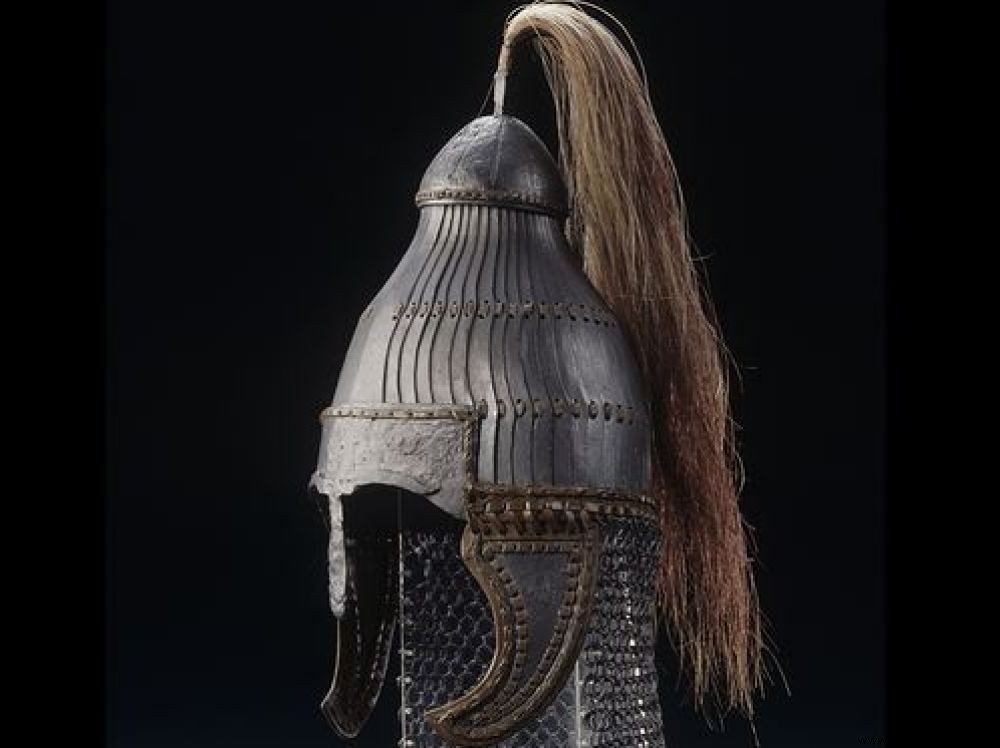
Helmet with crest found in the medieval cemetery of Niederstotzingen (Baden-Württemberg), Germany.
The cover of the online journal Science Advances dated September 2018 attracts particular attention. You can admire a magnificent 7th century crested helmet, adorned with a flamboyant mane illustrating an article on Alemanni warriors. A coalition of Germanic tribes already mentioned by the Romans, under the pen of Dion Cassius, in the III th century. Defeated at the Battle of Tolbiac in 496/497 by Clovis, King of the Franks - another German - they were incorporated into the kingdom of Louis the German during the Treaty of Verdun (843).
Interest in this coalition has been rekindled by recent genetic and chemical analyzes of remains excavated in 1962, Germany. In particular on the 13 male bodies (10 adults and 3 infants) found in rich tombs from the beginning of the VI th -VII e century (between 580 and 630), of which the researchers did not know the origin and the reason for the deaths. And the results obtained point to a surprisingly cosmopolitan origin of its occupants!
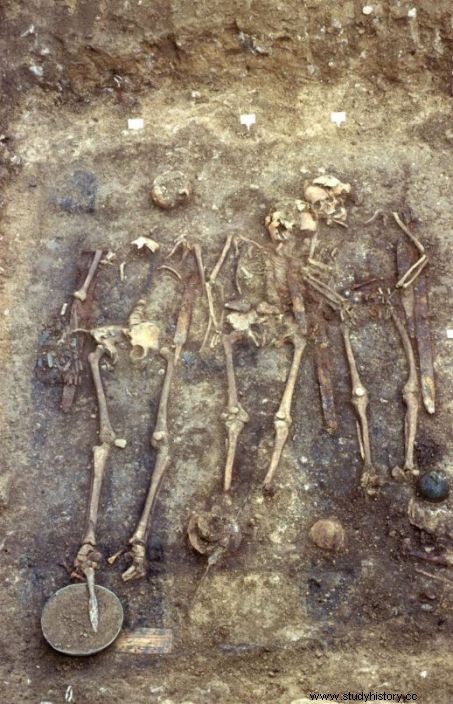 Warrior Elite Multiple Grave Found in VII
e
Cemetery> century from Niederstotzingen, Germany. © Landesamt fur Denkmalpflege im RP Stuttgart
Warrior Elite Multiple Grave Found in VII
e
Cemetery> century from Niederstotzingen, Germany. © Landesamt fur Denkmalpflege im RP Stuttgart
Indeed, some warriors came from regions very distant from the Alemanni territories corresponding to the south-west of present-day Germany (between the Rhine, Neckar and upper Danube). To obtain these results, experts led by archaeologist Niall O'Sullivan from Eurac in Bolzano (Italy) and the Max Planck Institute for Science in Jena (Germany) sequenced the genetic material taken from these skeletons.
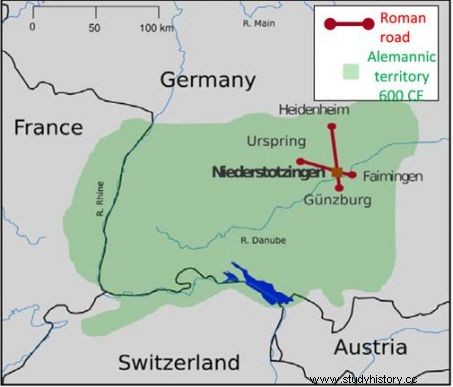 Map of the territory occupied by the Alamanni around 600, with location of the Nederstotzingen cemetery. (In red, ancient Roman roads). © Science Advances
Map of the territory occupied by the Alamanni around 600, with location of the Nederstotzingen cemetery. (In red, ancient Roman roads). © Science Advances
Result:While the majority of DNAs indicate geographical affinities with northern, eastern and central Europe, two were from southern Europe and the eastern Mediterranean, while five related individuals were buried with associated offerings to three different cultural origins, corroborating the idea that relatives and recruits from elsewhere (acquired by adoption or, abductions, etc ), benefited from the same attentions.
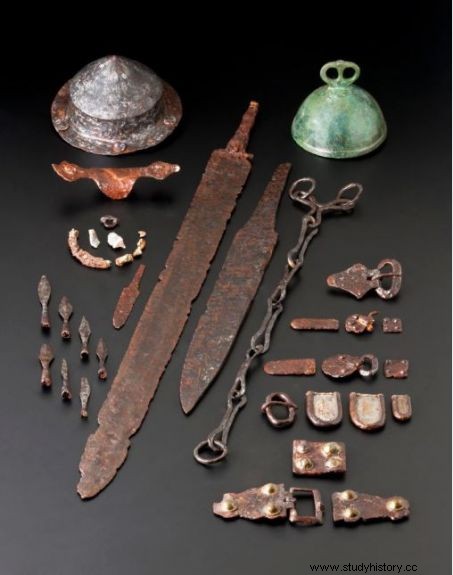 Weapons and equestrian equipment found in the graves of Alamanni warriors in Niederstotzingen, Germany. ©Landesmuseum Württemberg, P. Frankenstein/H. Zwietash
Weapons and equestrian equipment found in the graves of Alamanni warriors in Niederstotzingen, Germany. ©Landesmuseum Württemberg, P. Frankenstein/H. Zwietash
"This discovery is important, because it puts to rest a very tough misconception:no, the Germanic "barbarian" populations were not genetically "homogeneous"! As these data confirm, these peoples have in fact integrated into their culture and their way of life populations originating from lands and sometimes even from very distant civilizations, very different from theirs “, explains to Sciences et Avenir Laurent Olivier, archaeologist, chief curator of Heritage, in charge of the Celtic and Gallic collections at the National Archeology Museum of Saint-Germain-en-Laye (Yvelines). Until then, specialists considered that the bodies found near Niederstotzingen (Baden-Württemberg, Germany), emanated from a class of itinerant Alamanni warrior kings, as Science Advances recalls. .
Besides the remains of three horses and equestrian equipment, extraordinary leather-stitched helmets, swords and armor had been unearthed from these remarkable tombs, as well as precious objects:finely carved clothing, jewelry or combs.
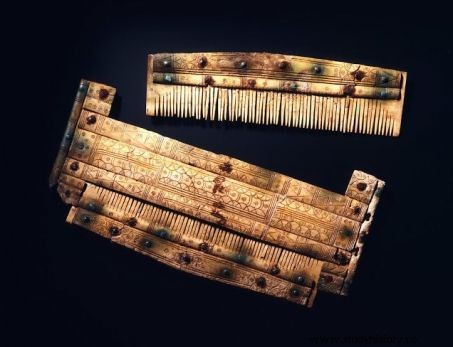 Delicate comb with case from one of the Niederstotzingen burials. ©Landesmuseum Württemberg, P. Frankenstein/H. Zwietash
Delicate comb with case from one of the Niederstotzingen burials. ©Landesmuseum Württemberg, P. Frankenstein/H. Zwietash
These creations attest above all to the fact that the high-ranking figures buried were in contact with the Franks, the Lombards (northern Italy), but also with populations from the eastern Mediterranean and Byzantium. The presence of foreigners among the Alemanni warriors is also corroborated by historical testimonies, "in particular, the practice of hostages explains Laurent Olivier. As part of alliances, dominant families could make exchanges, or deliver individuals to an overlord following defeats" . Julius Caesar evoked these customs in the "Gallic War". "To explain these foreign presences, it is furthermore possible that there was much more mobility between individuals than previously thought, and that it was easier to pass from one culture to other than imagined “said Laurent Olivier. A hypothesis that could also be supported by the etymology since the term Alamans comes from the German "all-mans meaning "all men" or "people of all kinds"...
"The German-speaking society is poorly known beyond its very warlike nature, the habit of wearing long hair dyed red and a well-established paganism writes historian Hervé Huntzinger in “Les Barbares », published in 2016 under the direction of Bruno Dumézil. However, a mystery remains. How did these warriors from Niederstotzingen are they dead? None of the remains showed signs of trauma or disease. Something to give researchers a little more grain to grind.
